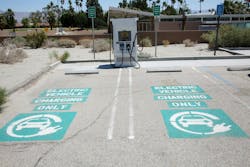NOVI, Michigan—Tesla launched its Model Y in 2020, and shortly after that, Tesla’s value in the market skyrocketed. As of the first quarter of this year, the Model Y is the top-selling vehicle in the world, surpassing the Toyota Corolla.
U.S. consumers’ reaction to the Model Y’s launch in 2020 signaled to the rest of the world and vehicle OEMs that electric vehicles were worth the investment. Following suit a year later, the Detroit Three—Ford, General Motors, and Stellantis—announced a “shared aspiration to achieve sales of 40-50% of annual U.S. volumes of electric vehicles ... by 2030.” And many U.S. startup electric vehicle manufacturers have made a name for themselves in the market since then. European automakers have also introduced electric vehicles into the market rapidly, giving consumers and professionals plenty of green vehicle options.
The number of electric vehicles purchased by Americans has set quarterly records since Q3 of 2020. Using data from Kelley Blue Book, Cox Automotive estimates year-to-date U.S. EV sales will surpass one million for the first time this month.
See also: Zap! Depot operations show electric truck potential growing
But no one said the road to emission-free vehicles would be smooth. Last month, GM announced it is delaying production of its GMC Sierra EV and Chevrolet Silverado EV until 2025. Ford announced it is losing money on electric vehicles despite their popularity.
At the Motor and Equipment Manufacturers Association annual conference held here in Metro Detroit, Brandon Boyle, a senior partner for automotive with consultant Roland Berger, told a room of supplier executives that the industry could be shifting from the electric vehicle boom it has experienced in the last few years.
Automakers set lofty EV goals, and the federal government has joined in as the Biden administration set lofty goals and funding to have EVs make up 50% of all vehicles sold in the U.S. by 2030. But are these goals attainable?
"There are a lot of questions on whether or not this is really feasible," Boyle said to the group. "I keep getting asked these questions every time that I meet with different clients: 'Do we think this forecast is real?' 'Are the material supply chains going to be ready?' 'Will there be enough charging infrastructure?' 'Are the grids robust enough for EVs?' 'Doesn't this help China?' And the list goes on and on."
See also: ABCs and 123s of charging infrastructure
The end of the EV boom
Boyle said he believes the EV boom is over due to three reasons:
- Companies are already modifying their EV expectations.
- Politics and deglobalization impact the development of BEVs.
- Issues in the supply chain must be resolved to hit a target of 50% EVs by 2030.
A look at expectations in the market indicates that reaching the government’s EV goals could take longer than expected. Boyle cited CATL as an example. The Chinese EV battery manufacturer recently reported a slowdown in its profit growth. OEMs, such as Mercedes, Tesla, and GM, are “talking about slowing down their expectations,” Boyle said. Another indication is that dealers just aren’t pushing EV sales, Boyle said, mentioning a conversation he recently had with a dealer.
Politics and deglobalization are helping to slow the momentum behind EVs in a few ways. The IRA and tax credits were designed to encourage U.S. production of EVs, EV batteries, and alternative fueling and charging infrastructure while discouraging the reliance on Chinese goods and production. At the same time, the influx of Chinese EVs into Europe prompted the European Commission to launch an investigation upon evidence that Chinese EVs could pose a threat to the European auto manufacturing industry.
Finally, India’s recent rejection of the Chinese EV company BYD’s $1 billion factory helped solidify global concerns about national security regarding Chinese technology within the auto industry, Boyle suggested. Regardless, China continues investing in the European, Central, and South American markets.
Boyle’s last indicator that we’re seeing the end of the EV boom lies in the continual supply chain issues. “Flawless execution” across the entire value chain is required for the industry to sustain the EV boom, and Boyle doesn’t expect that to become a reality. Sustaining the boom would require significant developments and even more capital investment in lithium reserves and cobalt and nickel mining to produce batteries. The U.S. also has a shortage of resources and skills—engineers and workers—required to alleviate supply chain woes. There’s also equipment lead time, sometimes up to 24 months, that could also slow EV production.
See also: Nikola says battery fix might need design change
Boyle noted that the compounding effect of these three key components—companies modifying their expectations, the impact of politics and deglobalization, and supply chain issues—all point to an “uphill climb” that would require the U.S. to have 50% EVs by 2030.
If we’re past the EV boom, are we now experiencing the EV bust?
Does the end of the EV boom mean they're a bust?
The U.S. government has supported electric vehicles and has supplied money and tax credits to prove it. Not only has the government invested billions, American OEMs have invested billions into EV production. So much investment has been poured into the emerging EV industry that "it's really hard to turn back at this point," Boyle said.
Automakers are also making EVs more affordable; they are no longer a luxury only the wealthy can afford. OEMs are making EVs that appeal to the mass market. Combined with the fact that OEMs have set company-wide CO2 targets themselves, Boyle said OEMs are "very incentivized" to continue developing EVs.
Bringing politics back into the equation, EV manufacturers and suppliers are building factories in red and blue states, providing jobs to thousands of individuals in rural and urban areas. This offers some funding security in the electric vehicle manufacturing industry because, even if a new political party comes into power in the next presidential election, politicians are typically "reluctant to take away tax benefits or things that are benefiting the population," Boyle said.
Therefore, considering the support, funding, and OEM motivation—not to mention the record-breaking EV purchases happening quarter after quarter—an EV bust happening now or in the future is unlikely, Boyle said.
Where the EV industry stands today
"Our view on this is that the reality will actually be somewhere in the middle of boom and bust," Boyle told the group. And what will that look like?
Expect a delay in the trajectory to reach that goal of EVs making up 50% of the vehicles in the U.S.—perhaps a delay of three to five years. Boyle and his team refer to this delay as a "blip" rather than a boom or a bust.
This delay is likely because of the time needed to smooth out the wrinkles in the supply chain and the time required to continue building out charging infrastructure. By 2030, Boyle expects to see EVs make up anywhere between 25% and 45% of vehicles in the U.S., but "there are scenarios that could actually drive that either in a more positive direction or more negative direction," Boyle said, emphasizing the uncertainty the market continues to face.
The scenarios that could move that trajectory include addressing infrastructure issues, major supply disruptions, and sustaining economic growth. However, any loss in regulatory support could drastically affect the trajectory negatively, and Boyle said that could also depend on the geopolitical tensions with China.
Only time will tell when and how the U.S. will see a 50% EV future, whether that's in 2030, the initial target year; in 2035, Boyle's projected year; or even later. Regardless, OEMs have continued to develop new electric vehicles for consumers and professionals. Although some hype might have waned, there is still plenty of interest and support for a future with more electric vehicles on U.S. roads.
About the Author
Jade Brasher
Senior Editor Jade Brasher has covered vocational trucking and fleets since 2018. A graduate of The University of Alabama with a degree in journalism, Jade enjoys telling stories about the people behind the wheel and the intricate processes of the ever-evolving trucking industry.

